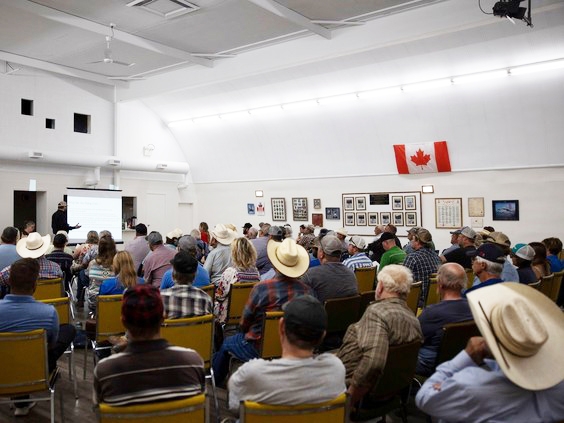
Brandon Harder
Regina Leader-Post
Along Highway 37, headed toward Cabri, an unrelenting sun continues its assault on the land that drives the region’s economy.
Standing crops look anemic, and the pastures are pocked with dirt-brown sores — environmental leprosy brought on by drought, here in the southwest.
It’s the first day of August, and pickup trucks are parked around a hall in the town where the highway ends.
Inside, around 100 people are gathered for a meeting called by the Saskatchewan Cattleman’s Association (SCA) — the third in a recent series of meetings exploring the situation faced by producers in various locations around Saskatchewan.
“We want to hear from you,” a representative tells the crowd, to whom he shows a short computer presentation on efforts made by the organization with a mandate to “to provide a united voice for the province’s beef industry.”
He offers a reminder that there are mental health supports available to those who need them, in a challenging year.
Folks in the seats are composed, with most offering a chuckle in response to the odd wise crack, but the tension in the room is thinly veiled.
It rises to the surface at times, as a Saskatchewan Crop Insurance Corporation (SCIC) rep fields questions that make it clear that the structure of coverage offered has not been working well for some in the room.
“Let’s see the formula,” one man says loudly, having offered a criticism of coverage as it relates to the price of hay.
The price of feed will be a serious issue this year for ranchers with parched pastures and writeoffs for hay crops.
Doing her best to explain the Crown corporation’s process, the SCIC rep reminds the man there’s “no crystal ball” that can be used to predict a coming year’s conditions — a reminder that offers little satisfaction to many here.
“Your formula is flawed,” the man says.
For some time, the woman tries to square the mechanisms of bureaucracy with what many in the room view as common sense, before one man finally relents and breaks the tension.
“Thank you for coming out today,” he offers, adding that she’s probably wondering why she came at all.
This draws another chuckle from the crowd.
‘Stop the bleeding’
But then another woman stands and addresses the room, including the politicians, local, provincial and federal, in attendance.
“All of us have been through drought. I don’t think any of us have been through one quite this long or quite this drastic,” she says.
She asked who should people go to when crop insurance fails to meet their needs and should emergency measures be taken when needs reach a certain criteria?
Noting some families may be forced out of the cattle business, she says: “I think we have to do something to stop the bleeding,”
“Have you guys got any ideas for what that is?”
In some other towns, halls are empty. Off of some other highways, crops look good enough to be featured in hopeful photos attached to government literature — the kind that folks working for David Marit might put together.
But the Minister of Agriculture has seen the bleeding. He’s seen plenty.
He says things are tough in places along the west side of the province, through Kindersley and up North Battleford way. He’s driven the south country through Assiniboia and over to the Cypress Hills. In many places, the scenery is the same as it is along much of Highway 37.
Devastation is the word he uses to describe it.
“It’s pretty heartbreaking to hear some of the stories,” he says. As of Aug. 2, some 44 rural municipalities had declared disaster, according to Saskatchewan’s Minister of Agriculture David Marit, who offered comments to the Leader-Post in an Aug. 3 telephone interview.

